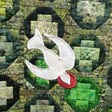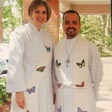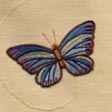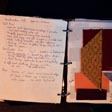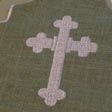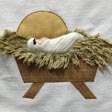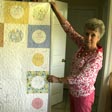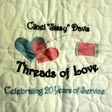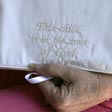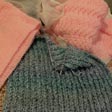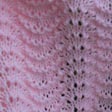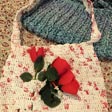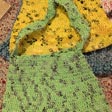Stitching Community: Fiber Arts and Service
By Laura Marcus Green

Stitching Faith: Handwork as Devotion
For those who have a passion for handwork and an abiding spiritual faith, combining these areas provides a personally fulfilling activity and a way to contribute to their community. Handworkers practicing artistically and culturally diverse fiber arts traditions universally report that stitching is akin to meditation, because of the concentration this type of work requires and because of its relaxing quality. In the context of the spiritually focused fiber arts projects presented here, the artistic process itself becomes a form of prayer.
Joyce Perry: Vestments and Paraments for St. John's United Methodist Church
Joyce Perry is a lifelong Methodist and a lifelong seamstress. At the invitation of a former minister's wife, she took part in sewing vestments and paraments (the cloths with which a church altar and pulpit are dressed) for an area church. When the minister and his wife moved to another community, Joyce continued working on the project and began making these items for her home church, St. John's United Methodist Church in Baton Rouge. This undertaking has resulted in a cycle of handmade hand-made vestments and paraments that beautify and personalize the dressing of the church for various occasions.
Joyce carefully designs these sets, drawing upon the color and symbolism for each season in the Methodist calendar. Ordinary Times, which take place between special points of the year, are represented by the color green. For Lent there is purple, and Easter is white. Advent and Christmas are also purple. Pentecost in June, when the Holy Spirit descends, is symbolized by reds and golds. Joyce has also designed a set of paraments with a "Holy" design, in ivory and gold for special occasions like funerals, weddings, and days like the Baptism of Christ and Trinity Sunday. In addition to the colors she uses in her work, Joyce draws upon particular symbols, such as the dove or flames for the Pentecost, and Alpha and Omega to represent God as the beginning, end, and always.
Designing and creating these special pieces is a spiritual journey for Joyce, who includes prayer—which she regards a form of listening—in each step. In addition to beautifying the church, she hopes that her work provides fellow congregants with a meaningful spiritual vehicle of their own to interpret in any way that works for them. Joyce's service to her church embodies the idea of agape, a gift freely given with nothing expected in return. A retired teacher, she has made other items for church activities, has taught a sewing class for clients of the church's food pantry, and is an active participant in Baton Rouge's vibrant quilting scene.
Sissy Davis: Threads of Love
Just before retiring from her career as a school bus driver, Sissy Davis raised her hand in church one day when the call came from a local hospital for hand-sewn clothes for premature, stillborn, and miscarried babies. As she put it, "I can't sing in the choir, but I can sew!" Over twenty years later, Threads of Love is not only a ministry at Sissy's church, but has chapters all over the United States and several overseas. Over the years, Sissy has formalized the work, with instructional manuals for chapter leaders and members, and a biennial meeting that brings together chapter members from around the country to learn, share, and provide mutual support. Threads of Love's operations touch upon occupational folklife, as Sissy has forged relationships with doctors, nurses, coroners, and funeral directors, honing her project to work effectively with these service providers.
Sissy has developed nine different sizes of gowns for babies, depending on their situation or stage of growth. There are other items she has developed in collaboration with medical professionals, such as gowns that allow for wires and tubes in neo-natal care units and "lovie dolls" that help mothers and babies bond during babies' isolation. Threads of Love provides comfort and support to families and the medical professionals who care for them at a time of life that most people find hard to think about or discuss. In her interview, Sissy addresses the change in societal attitudes towards losing a baby, a shift she personally has experienced since she lost a baby brother when she was thirteen years old.
Threads of Love is first and foremost a church ministry and maintains its spiritual dimension. Each Threads of Love kit—a robe, blanket, diaper, sometimes a cap—comes with a prayer that is appropriate to the recipient's situation. For Sissy and the many volunteers who work with her to provide these items, their donations are a manifestation of God's abiding presence and love.
Saroj Welch: St. John's United Methodist Church Prayer Shawl Ministry
Saroj Welch is a lifelong Methodist and a lifelong knitter. Growing up in India, she was instilled with a sense of community service by a father who was a professor at a Methodist theological seminary and a mother who was a social worker. Unlike most women of her time in India, Saroj was encouraged to pursue a profession, to be able to stand on her own two feet, even while excelling at the domestic arts. When attending Northwestern University in the United States, Saroj met her American husband, Carlos Welch. The two have spent much of their married life in India, working as a team for the Methodist Church and administering pastoral and clinical psychological care. After many years of living in India, the two retired to Carlos's home state, Louisiana, where they remain involved with the Methodist Church and community affairs.
At a national conference for Methodist women, Saroj learned of the Prayer Shawl Ministry, a national network. Back home in Baton Rouge, she and others at St. John's United Methodist Church formed a local Prayer Shawl Ministry. The group makes shawls for individuals in need, and also tries to keep a stash on hand, should the need arise more spontaneously. The shawls are always made with patterns based on three stitches and are made from three skeins of yarn, representing the Holy Trinity. The knitters pray for the recipients while making a shawl, then hold a covenant meeting during which they pray over the shawl. When they present the recipient with a shawl in person, they pray with and for that person, while wrapping them in the shawl. Recipients report the feeling of being wrapped in love, which helps them cope with whatever situation they may be dealing with—an illness or loss of a loved one, among other issues.
The founders of the national Prayer Shawl Ministry have published pattern books that provide specific patterns and prayers for various occasions. For example, there is a pink lacy shawl that is made for breast cancer survivors. In her interview, Saroj describes the process of making and giving a prayer shawl, and its impact on the recipients. Saroj also crochets purses out of recycled plastic shopping bags. The funds she raises through the sale of these purses goes towards missionary projects.



